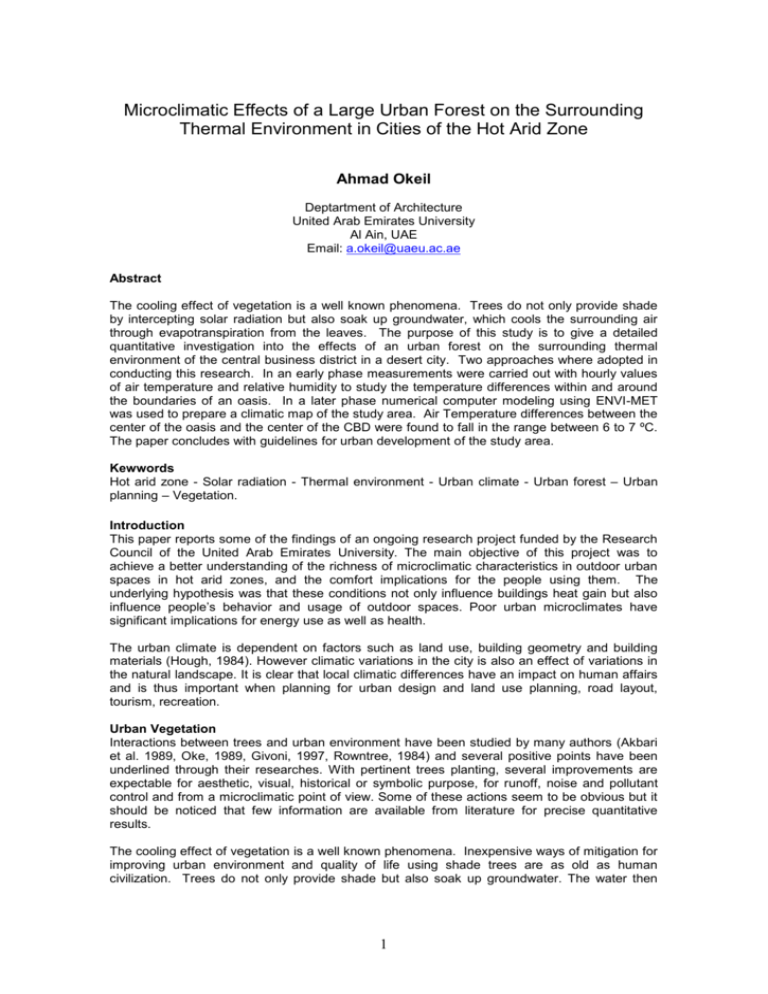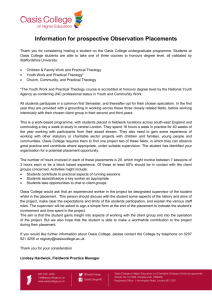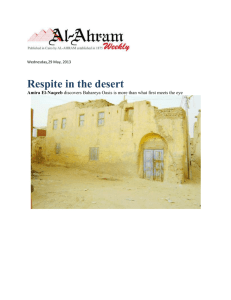Abstract - Resource for Urban Design Information
advertisement

Microclimatic Effects of a Large Urban Forest on the Surrounding Thermal Environment in Cities of the Hot Arid Zone Ahmad Okeil Deptartment of Architecture United Arab Emirates University Al Ain, UAE Email: a.okeil@uaeu.ac.ae Abstract The cooling effect of vegetation is a well known phenomena. Trees do not only provide shade by intercepting solar radiation but also soak up groundwater, which cools the surrounding air through evapotranspiration from the leaves. The purpose of this study is to give a detailed quantitative investigation into the effects of an urban forest on the surrounding thermal environment of the central business district in a desert city. Two approaches where adopted in conducting this research. In an early phase measurements were carried out with hourly values of air temperature and relative humidity to study the temperature differences within and around the boundaries of an oasis. In a later phase numerical computer modeling using ENVI-MET was used to prepare a climatic map of the study area. Air Temperature differences between the center of the oasis and the center of the CBD were found to fall in the range between 6 to 7 ºC. The paper concludes with guidelines for urban development of the study area. Kewwords Hot arid zone - Solar radiation - Thermal environment - Urban climate - Urban forest – Urban planning – Vegetation. Introduction This paper reports some of the findings of an ongoing research project funded by the Research Council of the United Arab Emirates University. The main objective of this project was to achieve a better understanding of the richness of microclimatic characteristics in outdoor urban spaces in hot arid zones, and the comfort implications for the people using them. The underlying hypothesis was that these conditions not only influence buildings heat gain but also influence people’s behavior and usage of outdoor spaces. Poor urban microclimates have significant implications for energy use as well as health. The urban climate is dependent on factors such as land use, building geometry and building materials (Hough, 1984). However climatic variations in the city is also an effect of variations in the natural landscape. It is clear that local climatic differences have an impact on human affairs and is thus important when planning for urban design and land use planning, road layout, tourism, recreation. Urban Vegetation Interactions between trees and urban environment have been studied by many authors (Akbari et al. 1989, Oke, 1989, Givoni, 1997, Rowntree, 1984) and several positive points have been underlined through their researches. With pertinent trees planting, several improvements are expectable for aesthetic, visual, historical or symbolic purpose, for runoff, noise and pollutant control and from a microclimatic point of view. Some of these actions seem to be obvious but it should be noticed that few information are available from literature for precise quantitative results. The cooling effect of vegetation is a well known phenomena. Inexpensive ways of mitigation for improving urban environment and quality of life using shade trees are as old as human civilization. Trees do not only provide shade but also soak up groundwater. The water then 1 evapotranspires from the leaves thus cools the leaves and, indirectly, the surrounding air (Sukopp, 1982). In this sense, the active equivalent system to a mature tree would be an electromechanical system consisting of a shading device covered with photovoltaic converting solar energy into electricity to drive a water pump that soaks up water from the ground and pumps it through an array of very fine sprinkles. The energy required to evaporate water is taken from the air and from the sunlight intercepted by the leaves. A single mature, properly watered tree with a crown of 9 m can "evapotranspire" up to 40 gallons of water in a day, which is like removing all the heat produced in four hours by a small electric space heater. Trees are also very effective in shading the ground, thus preventing the heating of the surface by sunlight. In hot-arid regions the rate of evaporation from bare soil is small. However, in irrigated urban parks and gardens, water evaporation increases from the plants and soil. Therefore the effect of green areas on the urban climate within and near the "green" areas can be significant, and the effect on comfort desirable (Givoni, 1997, Asaeda and Ca, 1998). The effects of plants on the climate in the built-up area depend on the fraction of "green" areas, public as well as private, relative to the whole built-up urban area. The effect of urban plants can be different, under different planting schemes, with respect to the air temperature, solar exposure of pedestrians, and the wind speed in the streets, depending on the particular choice of the plants and the details of the landscaping. In high-density cities, where most of the land is covered by buildings and roads, and where very limited area is available for plants, the effect of plants on the air temperature may be rather small. Their main contribution to the urban climate may be in providing shade for pedestrians. Ongoing research has shown that urban vegetation can substantially conserve cooling energy (Heisler 1986, Huang et al. 1986). These savings result from the direct effects of such actions in reducing the heat flow into conditioned spaces in buildings. Yet large additional savings may indirectly accrue from the reduced air temperatures on the scale of a neighborhood or city (Kurn et al. 1994) Although a lot has been written on the thermal effect of plants in urban areas, not many experimental studies were done on the subject. The following case study is to give a detailed qualitative investigation into the effects of vegetated areas on the thermal climate of the downtown area of Al Ain city through field observations as well as numerical simulation. Case Study: Al Ain Oasis as an Urban Forest The study area is located within Al Ain city (+24.15ºN and +55.36ºW), a new, well-planned desert city in the south east corner of the United Arab Emirates. Originally it was a cluster of small villages built around a great pool of water that marks the spot where an underground aquifer floods to the surface of the desert. At present the town covers an area of 40 km2 and has a population of about 300,000. The study area, which is near the down town area, has the size of about 4.0 km 2 from which 1.0 km 2 are covered by the main oasis as shown in figure 1. The vegetation of the oasis consists of around 160000 large palm trees whose cups touch each other in addition to few beds of shrubs and grass between them as shown in figure 2. Summer and winter permeability of solar radiation was found to be in the range from 18 to 30 percent. The canopy covers about 80 percent of the land area and the soil is wet from irrigation in the intervals between watering through open ditches and canals. 2 Figure 1 Arial photo of the study area. Al Ain oasis surrounded at a distance by the downtown area in the east, north and west direction. Empty areas stretch around the oasis between its boundaries and the urban area and remain undeveloped. The streets East, North, and West of the oasis are residential-commercial streets with 5 story multi-family houses and considerable green spaces together with paved parking lots as shown in figure 3.a and 3.b. The area is part of the city’s central business district. The street South the oasis is serving as a traffic artery and is separated from the oasis by some sport facilities as well as empty undeveloped areas. The oasis is seen as a natural reserve, which contains an ecosystem so sensitive to trampling, littering, etc. that city authorities and plantation owners are only able to protect it by erecting fences and prohibiting trespassing. By taking such measurements it was possible to preserve this ecosystem of the original landscape within the urban area. In recent years city authorities worked on the integration of nature into the urban. Main walkways in the oasis were paved with natural stone and the fences along the walkways were reinforced as shown in figure 4. Several small play areas for children, cafes and benches along the walkways are available for the oasis visitors at path intersections as shown in figure 5. Still, most of the observed persons in the area are workers, plantation owners and very few visitors. 3 Figure 2 Palm plantations in the oasis at one of the less dense spots. Figure 3.a, 3.b Residential-commercial 5 story buildings, parking lots and considerable smallscale urban vegetation surrounding the oasis at a distance. Figure 4 Vehicular and pedestrian paths in the oasis paved with natural stone and new fences to prevent trespassing through the plantations. 4 Figure 5 Small play areas, cafes and sitting areas along the walkways intersections. Field Measurements The main objective of the study was to see if there is a difference in the temperatures inside the park and in the built-up areas around it and, if so, how far the oasis effect is extending. Two approaches where adopted. In an early phase field measurements were carried out. In a later phase results from phase one were used to validated climatic maps simulated by the numerical computer modeling ENVI-MET. A complete permanent meteorological station was set-up at the boundary of the oasis. A large number of temperature-moisture sensors installed in thermal shelters at 1.2 m above ground were deployed within and around the oasis and outward from the oasis throughout the city in all directions. In selecting sensor locations effort was made to find representative points in the heterogeneous urban terrain. Occasionally measurements at 1.2 m above ground above land areas with different ground treatments were recorded. The ground treatments included a shaded sidewalk, unshaded paved sidewalk, an exposed sand area, and a parking lot. The northernmost field sensor served as a control from which deviations of the air temperature at the other stations were calculated as "effects." Observations were carried out during different periods over an entire year (August 1999-August 2000). During the observations, 15-minute values of air temperature, relative humidity and wind velocity were measured. Numerical Simulation using Envi-met ENVI-met consists of a three-dimensional non-hydrostatic microclimate model which provides the microclimate conditions in urban and suburban areas. It was developed by Michael Bruse (Bruse, 2001). The simulation was performed over a 2.1 x 2.1 km domain with a horizontal grid resolution of 30 meters. Aerial photographs of 2m/pixel resolution taken over Al Ain were used as a basis for creating the model as shown in figure 6. 5 Tree types, soil profiles accounting for terrain effects and resolving building clusters were then used to drive the ENVI-met model at grid resolutions on the order of 30 meters as shown in figure 7. Simulations for four consecutive days in each month of the year were conducted and the results are stored into a database for future use. Simulations were time consuming and it was found that the computer model refused to run unless very high hardware requirements were available. The outputs from the model such as near-surface air temperature, wind velocity, wind direction as well as their vertical profiles were compared with observed variables obtained at the automated weather station. The simulated air temperature agreed well with the measurements taken by sensors. At some points, however, the model overestimated the minimum air temperatures in the early morning. Simulation results were used to prepare different climatic maps as shown in figure 8. These maps will be used when planning for any future development of the study area. Figure 6 Arial photo of the study area used in ENVI-met as a basis for building the simulation model. 6 Figure 7 Detailed view of the ENVI-met model showing boxes representing different land cover surfaces, different vegetation types and different buildings characteristics. Observations and Discussion of Measurement and Simulation results Although field measurements and numerical simulation were carried out for the whole year, the following discussion of the results will be limited to a summer days. Results of the observations and analysis reveal that in the early morning hours after sunrise the highest air temperatures could be measured in the empty areas between the oasis and the urban area. No air temperatures differences could be detected between the oasis and the surrounding streets. This is because in the morning hours the street is in the shade due to the low sun angle and the high multistory buildings located on both sides of the street. The cool ground surface results in a cooler air temperature, compared with that of a sunlit area, despite the high value of anthropogenic heat. As the sun angle increases streets are flooded and the air temperature in the streets increases rapidly. By 10:00h no air temperature differences between the empty areas and the streets could be detected. The oasis protected by the canopy is 2.8 0C cooler than the surrounding streets. At noon, the air temperature difference between the oasis and the nearby commercial area is more than 4.50C. Additionally, the reduction of solar radiation due to tree shelter improves much thermal feeling. The highest temperatures were measured in the north and west traffic street, apparently reflecting the effect of high solar radiation, vehicular traffic, energy released from heated pavement surfaces, and energy released from air conditions. Near the oasis, at distances of 25 m in the downwind field, the temperatures were only slightly above the oasis temperatures. At a distance of 150 m the temperature in the streets was about 1.2 0C above the average temperatures in the oasis. 7 At 14.00h, the air temperature difference between the coolest and hottest places in the study area amounted to more than 6.50C. The lowest air temperature of 380C is observed in the center of the oasis. The highest air temperature in parking lots at Khalifah street was more than 460C. With a hot asphalt surface, the most likely candidate contributing to the high air temperature is the sensible heat released from the surface. Since this site is located upwind in the commercial area, anthropogenic heat released by air conditioning, traffic and other commercial activities can contribute significantly to the heating of air. At 20:00h the hottest places observed remain parking lots at Khalifah street with an air temperature of 380C. At this time, the heating of the atmosphere is due to the release of heat from the pavement surface in the form of sensible heat, upward longwave radiation and anthropogenic heat. The air temperature difference between the oasis and the urban area amounts to more than 3.00C. The coolest point at that time is in the empty area between the oasis and the urban area due to the unobstructed radiation cooling. As the night progresses surfaces in the urban area cool down all stored energy has been released. This reduces the air temperature in the streets to the same level found in the empty area. Extensive tree-cover inhibited nighttime radiation cooling in the oasis due to the reduced Sky View Factor. The minimum average temperature in the center of the oasis is 2.00C higher than in the urban area. Data on surface temperature at many locations in the study area show that the surface temperature of the asphalt road and concrete pavement rose to more than 80 0C at noon, almost 340C higher than that of the air. At the same time, grass surface temperature reached its maximum of 52.00C, only about 6.00C higher than the air temperature. The quantitative air temperature differences between the oasis and the surrounding urban area are affected by the wind conditions. The average maximum wind speed in the oasis is much lower than in the open upwind area, 2.8 m/s vs. 6.5 m/s. The wind direction is from the northwest. So, the street north west of the oasis was upwind and that south east of the oasis was downwind with respect to the oasis. From the observational results, it is found that the oasis is significantly cooler than the surrounding area during the day and slightly warmer at night. With strong local winds during the day, it is to be expected that the cool air from the oasis significantly contribute to the reduction of the heat intensity in the town. The effect of a drop in urban air temperature caused by green cover depends on the distance from green cover. This effect also depends on both the size of the green cover and wind direction. It is found that with a strong local wind, the cool air from the oasis can improve the thermal environment in the downwind direction to the distance of more than 200m beyond which no noticeable effect of the oasis can be detected. Application of Results in Urban Planning Observations indicate that the size of an urban forest “oasis”, beyond a given limit, makes little difference in the climatic conditions within its boundaries and in the range of its effect. Thus the division of the entire space allocated for future green areas into a large number of small green areas, spread over the whole urban area, will have a greater effect on the overall urban climate, than would the creation of a small number of large parks. As the effect of large scale public green areas on the climatic conditions around buildings in the built-up sections of a city, away from the green areas, is rather limited, the effect on energy demand for heating and air conditioning, is also limited. In this respect, the effect of vegetation in private lots around buildings can be more significant. 8 Figure 8 Sample of ENVI-met output showing a climatic map describing the spatial variation of air temperatures in the study area at 14:00, July. The influence of the urban forest on the urban climate is limited to the conditions prevailing within these areas themselves, and extends only a short distance into the surrounding urban area. For this reason, the contribution of urban forests is primarily in their function as places providing outdoor areas for rest and recreation with a pleasant climate for people visiting them or living or working near to their borders. This suggests that the Integration of the oasis into the surrounding urban area could be achieved by planning the area in between as pedestrian paths and nodes with gathering spaces encouraging day and evening outdoor life while keeping the heart of the oasis isolated to reduce trespassing. 9 The ring road like pedestrian area should be kept from becoming backyards of the development thus diminishing the thermal comfort enhancing potential. This could be achieved through the integration of commercial activities facing the oasis. Thermal discomfort reduction in the pedestrian area requires minimizing radiating surfaces with shading. Trees, arcades and shading devices could be used for this purpose. Tensile structures intercepting solar radiation during the day and giving way to radiation cooling during the night could improve the microclimate significantly. Arcades should be incorporated in all new residential-commercial development along the boarder facing the oasis. Arcades, working as an interface between buildings and streets, create a climatic barrier to the building as well as encourage people to walk between them. The dominant wind regime carries hot air from the urban area to the oasis at the up wind side and cool air from the oasis to the urban area at the downwind side. Surrounding street patterns should be planned in a way that main streets run parallel to prevailing wind in order not to block these two airflows. Failing to do that would result in micro-climatic wind patterns taking the cool air above the surrounding buildings into the urban boundary layer where it is not made use of. Acknowledgment This work was performed under the auspices of the Research Council of the United Arab Emirates University under fund No. 13-7-11/99. References Akbari, H., A. Rosenfeld, and H. Taha. (1989). "Cooling Urban Heat Islands," Presented at the Fourth AFA Urban Forestry Conference, October 1989, 18-16 St. Louis, MO. Asaeda, Takashi and Ca, Vu Thanh, (1998). "A Case Study on the Effects of Vegetation on the Climate in the Urban Area,” in Urban Ecology, Breuste, J. ed. Springer-Verlag Berlin, p. 78. Bruse, Michael, (2001) ENVI-met Version 2.5. User Guide. Document in PDF format. Givoni, Baruch, (1997) Climate Considerations in Building and Urban Design, New York: Van Nostrand Reinhold. Heisler, G.M., (1986). "Effects of individual trees on the solar radiation climate of small buildings", Urban Ecology, p: 337-359. Hough, M., (1984). City Form and Natural Processes, New York: Van Nostrand Reinhold. Huang, Y. J., H. Akbari, H. Taha & A.H. Rosenfeld, (1987). "The potential of vegetation in reducing summer cooling loads in residential buildings", J. Climate Applied Meteorology, 26: 1103- 1116. Kurn, D. M., S. Bretz, B. Huang, and H. Akbari. (1994). "The Potential for Reducing Urban Air Temperatures and Energy Consumption Through Vegetative Cooling," Proceedings of the ACEEE 1994 Summer Study on Energy Efficiency in Buildings, August 1994, Pacific Grove, CA, 9, p. 155 Oke, T.R., (1989). "The micrometeorology of the urban forest", Philosophical Transactions of the Royal Society of Meteorology, London B, 324: 335-350. Rowntree, R.A., (1984). "Ecology of the urban forest", Urban Ecology, 8:1-11. Sukopp, H., (1982). Nature in Cities. Council of Europe nature & environment series 28. Strasbourg, Germany. 10








